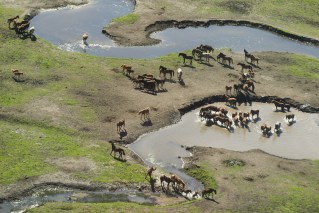AstraZeneca and Oxford University’s COVID jab is a ‘vaccine for the world’

Oxford University’s coronavirus vaccine is being hailed as a truly global solution to the pandemic because it is easier to transport and cheaper to produce.
British company AstraZeneca announced the vaccine was 70 per cent effective in trials but could be around 90 per cent effective with different doses.
Millions of the doses could be rolled out as soon as Christmas and Australia already has an order for 30 million doses, with 3.8 million potentially delivered in early 2021.
The Oxford jab is the third after US companies Pfizer and Moderna to excel in trials as the world appears on the cusp of having numerous vaccine solutions.
But unlike the previous two vaccines which require extreme cold temperatures for transport – which is expensive and difficult – Oxford’s version can be delivered in normal fridge conditions.
That would make the drug easier and cheaper to distribute around the globe, particularly to third-world countries.
“This means we have a vaccine for the world,” said Andrew Pollard, director of the Oxford University vaccine group that developed the drug.
By comparison the Pfizer vaccine needs to be shipped and stored at -70C, the sort of temperature typical of an Antarctic winter.
The Oxford vaccine’s cost works out at just a few dollars a shot, a fraction of the price of drugs from Pfizer and Moderna, which use a more unconventional technology.
AstraZeneca said it would have as many as 200 million doses by the end of 2020 – around four times as many as US competitor Pfizer.
Seven hundred million doses could be ready globally as soon as the end of the first quarter of 2021.

Duke of Cambridge (bottom right) congratulates Oxford researchers. Picture: Kensington Palace
The vaccine was 90 per cent effective in preventing COVID-19 when it was administered as a half dose followed by a full dose at least a month later, according to data from late-stage trials in Britain and Brazil.
No serious safety events were confirmed, the company said.
The effectiveness depended on the dosing, and fell to just 62 per cent when given as two full doses rather than a half-dose first.
But scientists cautioned against seeing this as evidence that it would be less useful than rivals.
Vaccines from Pfizer and Moderna each prevented about 95 per cent of cases according to interim data from their late-stage trials.
“I think it is a real fool’s errand to start trying to pick these three (Pfizer/Moderna/Astra) apart on the basis of snippets of phase 3 data from press releases,” said Danny Altmann, professor of immunology at Imperial College London.
“For the bigger picture, my suspicion is that by the time we are a year down the line, we’ll be using all three vaccines with about 90 per cent protection – and we’ll be a lot happier.”
Public health experts say the world will need many vaccines to meet global demand.
WHO chief scientist Soumya Swaminathan said the Oxford results were “encouraging and we look forward to seeing the data as we do with other promising results of recent weeks,” she said.
“We welcome the efforts of Oxford/AZ to make the vaccine affordable and easy to store, which will be good for countries and people everywhere.”
The AstraZeneca vaccine uses a modified version of a chimpanzee common cold virus to deliver instructions to cells to fight the target virus, a traditional approach to vaccine development and different from the path taken by Pfizer and Moderna, which rely on new technology known as messenger RNA (mRNA).
AstraZeneca, one of Britain’s most valuable listed companies, will now immediately prepare regulatory submission of the data to authorities around the world that have a framework in place for conditional or early approval.
It will also seek an emergency use listing from the World Health Organisation to speed up availability in low-income countries.
In parallel, the full analysis of the interim results is being submitted for publication in a peer-reviewed journal.
If successful, and if it’s approved by Australia’s Therapeutic Goods Administration, 3.8 million doses will be delivered to Australia in early 2021.
Australia’s CSL will then manufacture 30 million doses through to September.

Health Minister Greg Hunt hopes a vaccine could make masks a thing of the past. Photo: AAP
The federal government has also secured 10 million doses of the Pfizer vaccine, with hopes vaccination could begin in March.
The news comes days after Australian National University analysis revealed most Australians plan to get vaccinated against the coronavirus once it’s available.
The ANU survey of 30000 adults in August showed about three in five people would get the jab, while six per cent definitely won’t and another seven per cent probably won’t.
It also found females, people living in disadvantaged areas, those with more populist views and stronger religious beliefs were more likely to be hesitant to get vaccinated.
A separate survey of 1000 Australians found the same amount – six per cent – wouldn’t get the vaccine.
-with AAP








